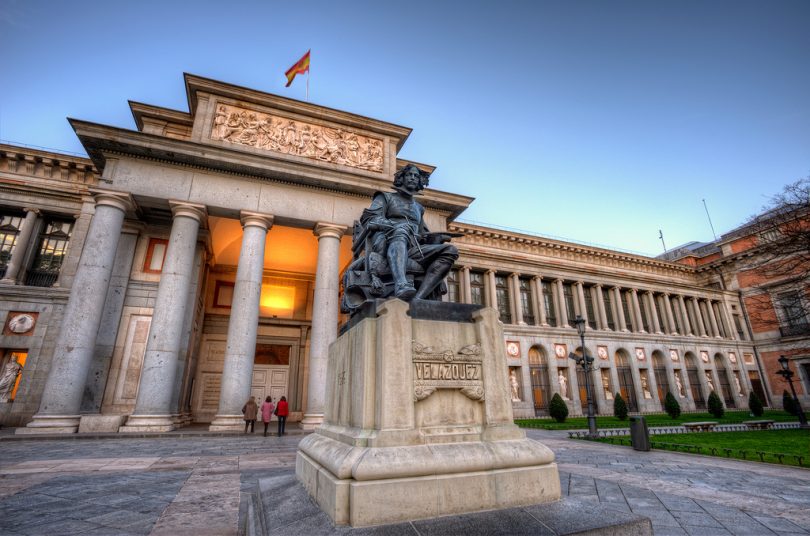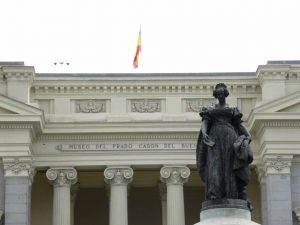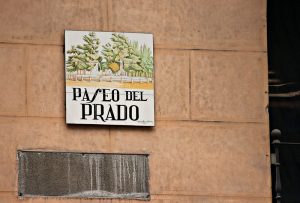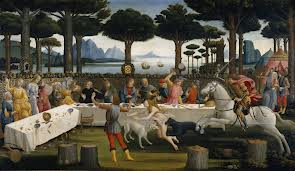One of the most important museums in the country is the Prado Museum in Madrid, also one of the most visited in Europe and, for many historians, the most important museum in the world in European art. This museum exhibits some of the most important artworks from names such as Velázquez, El Greco, Goya, Rubens, and Titian among others, and from those who have the best and most extensive collections that exist in the world. At ShMadrid, let’s get closer to the history and permanent exhibitions of the Prado Museum.
Related article: Discover the Museum of the Americas in Madrid
Index
History Of The Prado Museum
The Prado Museum was established in 1819 in the building previously built with the purpose of housing the Royal Cabinet of Natural History. This building was damaged during the War of Independence, leaving it in a deplorable state and almost in ruins. It was recovered, redesigned, and restored by the architect Juan de Villanueva. It was inaugurated as the Royal Museum of Paintings a year later, where some of the best works of the Spanish Royal Collection were exhibited with a total of 311 paintings exhibited in three different rooms. In the following years, the museum was expanded, even reaching the Museum of the Trinity in 1872, thus becoming a museum of national significance and being designated as the National Museum of Painting and Sculpture.
It was in 1920 when the museum was formally named the Prado National Museum (named after the street it’s located on Paseo del Prado) with its works and exhibitions, becoming the most important museum in Madrid, with a size of 41.995 m². This museum currently receives an average of more than 3 million visitors each year, being among the 20 most visited museums in the world. The Prado Museum has become a museum of reference worldwide and one of the most important tourist and cultural attractions of the city, including the essential routes to visit the rest of the capital.
Permanent Exhibitions
Many of the exhibitions that are in the Prado Museum are temporary, changing themes periodically. Among the exhibitions of permanent collections, through educational itineraries, we find the works of world’s greatest painters such as the largest ensembles of El Bosco, Tiziano, El Greco, Rubens, Velázquez, and Goya, with more than a hundred works in the collection. Also noteworthy are the works of Fra Angelico, Rogier van der Weyden, Juan de Flandes, and Rafael José de Rivera among other historical artists. Among these exhibitions, we can find some of the works that have become pieces of great value and admired by thousands of people. Some of the most important works in the permanent collection of the Prado are Las Meninas by Velázquez, Charles V at Mülhberg by Titian, La Maja vestida (above) by Goya, and The Three Graces of Rubens.
Enjoy these masterpieces where visitors can attend for free to different itineraries of the permanent and temporary exhibitions offered in different group tours through the museum’s rooms programmed to enrich the visit, facilitate art history, and arouse the interest of visitors in some aspect within the collections and exhibitions of the Prado Museum.
Related article: Discover Museo Cerralbo
Hours, Prices, And How To Get There
The general admission to the museum is €15 per person and €24 including the Prado guidebook, while the reduced entrance for retirees and students is €7.50. The Prado Museum opens its doors to the public from Monday to Saturday from 10:00 am to 8:00 pm, and on Sundays and holidays from 10:00 am to 7:00 pm. In addition, the museum is open for free for visitors from Monday to Saturday from 6:00 pm to 8:00 pm and on Sundays and holidays from 5:00 pm to 7:00 pm, with a 50% reduction in the price of admission to the museum’s temporary exhibitions. To get to the Prado Museum, located on the Paseo del Prado near the Fountain of Neptune, take the metro to Atocha on Line 1. Or, simply tell the cab driver the place and they will go. It is such an automatic place that there is no street number the building is labeled on.
Do not forget to visit one of the most important museums in the world, the Prado Museum in Madrid. Tell us what your favorite exhibitions are in the comments!









